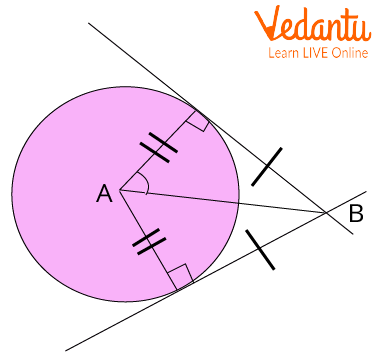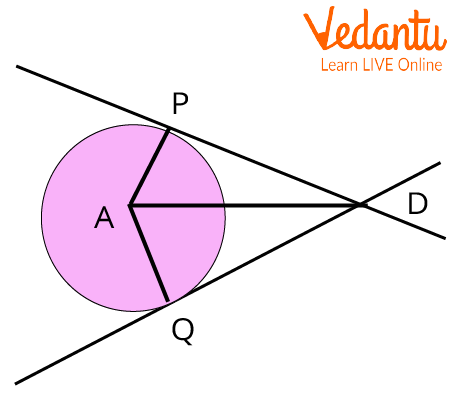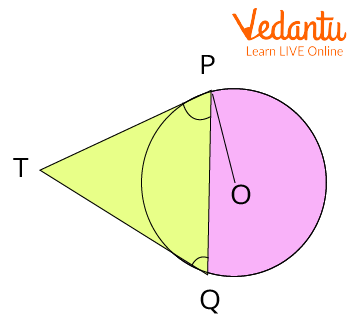




How to Apply the Tangent Segment Theorem in Geometry Problems
A tangent is a line drawn from a point on the circle connecting two points that are infinitely close to one another. In other words, we might state that Tangents are the lines that precisely cross the circles at a single point. The tangent's point of tangency is where it touches the circle. The radius is perpendicular to a tangent at the point of tangency. Due to its importance in geometrical constructions and proofs, it is related to numerous theorems.

Tangent to a Circle
What is the Tangent Segment Theorem?
According to the Tangent Segment Theorem, two tangent segments from an exterior point to a circle are congruent. The line connecting the exterior point and the point of tangency is referred to as a tangent segment.
In simple words, we can say that the tangent segments traced from an external point (point outside the circle) to the circle are congruent.

Tangent Segments Traced from An External Point to The Circle
Tangent Segment Theorem Proof

Tangent Segment Theorem Proof
Let A be the centre of the circle and the line DP and line DQ are the tangents to the circle at points P and Q, respectively. And we need to prove that the segment DP is congruent to segment DQ. So let’s draw a segment AD and radii AP and AQ. By the Tangent theorem, we know that the tangent at any point of the circle is perpendicular to the radius through the point of contact.
In $\triangle PAD$ and $\triangle QAD$,
$Seg AP \cong Seg AQ $ …(Radii of the same circle)
$Seg AD \cong Seg AD$ …(Common Side)
By the Tangent theorem,
$\angle APD = \angle AQD = 90^{\circ}$
And
$\triangle PAD \cong \triangle QAD$ …(Hypotenuse- Side Test)
Therefore, by CPCT,
$Seg DP \cong Seg DQ$
Hence Proved.
Applications of Tangents Segment Theorem
The tangent segment theorem can be applied to calculate the various angles that the tangents make.
Two tangent segments from an outside point to a circle can be shown to be identical by using the tangent segment theorem.
Tangent Segment Theorem Examples
1. In the figure given below, a circle with centre D touches the sides of $\angle ACB$ at A and B. If $\angle ACB$ is $52^\circ $, find the measure of $\angle ADB$.

A Circle and Two Tangent Lines
Ans: As known, the sum of all the angles of a quadrilateral is $360^\circ $.
And by Tangent theorem,
$\angle CAD\; = \;\angle CBD\; = \;90^\circ $
Therefore,
$\begin{array}{l}\angle ACB + \angle CAD\; + \angle CBD + \angle ADB\; = \;360^\circ \\ \Rightarrow 52^\circ + 90^\circ + 90^\circ + \angle ADB\; = \;360^\circ \\ \Rightarrow 232^\circ + \angle ADB\; = \;360^\circ \\ \Rightarrow \angle ADB\; = \;360^\circ \; - \;232^\circ \; = 128^\circ \\\angle ADB\; = \;128^\circ \end{array}$
2. Demonstrate that $AB = AC$ if AB and AC are tangent to circle O.
Ans: Let’s first draw a figure according to the given situation.

Equal Tangents
Now, we know
AB and AC are tangents to Circle O (Given).
The tangent lines are perpendicular to the radius of the circle. So,
$\angle ABO = \angle ACO = 90^\circ \;\;\;$
By reflexive property,
$AO = AO$(Common Sides)
As the radii of the circle are all equal.
So,
$OC\; = \;OB\; = \;r$
Therefore, $\vartriangle ABO\cong \vartriangle ACO~~$(Hypotenuse-leg )
Therefore, by CPCTC,
$AB = AC$
Hence Proved.
3. An exterior point T leads two tangents, TP and TQ, to a circle with the centre O. Prove that $\angle PTQ\; = \;2\angle OPQ$
Ans: Let’s first draw a figure according to the given situation.

Tangent Segment Theorem
By the Tangent Segment theorem,
$TP = TQ$
$\therefore \angle TQP = \angle TPQ$
Now,
OP is the radius of the circle and PT is the tangent, therefore,
$OP \bot TP$
So,
$\angle OPT = 90^\circ $
$ \Rightarrow \angle OPQ + \angle TPQ = 90^\circ $
$ \Rightarrow \angle TPQ = 90^\circ - \angle OPQ \cdots \left( 1 \right)$
In $\triangle PTQ$,
$\angle TPQ + \angle TQP + \angle PTQ = 180^{\circ}$
$ \Rightarrow 2\angle TPQ + \angle PTQ = 180^{\circ}$ (because $ \angle TPQ = \angle TQP$)
$ \Rightarrow 2(90^{\circ} - \angle OPQ )+ \angle PTQ = 180^{\circ}$ ( from (1)) $\Rightarrow 180^{\circ} - 2\angle OPQ + \angle PTQ = 180^{\circ}$
$ \Rightarrow \angle PTQ = 2\angle OPQ$
Hence Proved.
Important Points to Remember
A circle's tangent segments which are drawn from a point outside the circle are congruent.
Tangent segments to the circle form congruent angles with the line joining the point to the circle's centre when released from a point outside the circle.
Important Formula from the Theorem
According to the tangent segment theorem, if tangents are drawn from an external point(P) of a circle with centre O, then both tangents at point Q and R are congruent,
PQ = PR.
Conclusion
In this article, we have thoroughly discussed the tangent segment theorem and its proof. From the discussion above about the tangent segment theorem, we can conclude that two tangent segments from an exterior point to a circle are congruent.
FAQs on Tangent Segment Theorem Explained for Students
1. What is the fundamental definition of a tangent to a circle?
A tangent to a circle is a straight line that touches the circle at exactly one point, known as the point of tangency. A key property is that the tangent is always perpendicular to the radius of the circle at this point of contact.
2. What is the Tangent Segment Theorem?
The Tangent Segment Theorem states that if two tangent segments are drawn to a single circle from the same external point, then their lengths are equal. For instance, if a point 'P' is outside a circle and tangents from P touch the circle at points 'A' and 'B', then the length of segment PA is equal to the length of segment PB.
3. What is the formula derived from the Tangent Segment Theorem?
The theorem doesn't have a complex formula but rather a statement of equality. If two tangents from an external point P touch a circle at points A and B, the relationship is expressed as:
PA = PB
This simple formula is powerful for solving problems involving lengths in geometric figures.
4. How is the Tangent Segment Theorem proven?
The proof of the Tangent Segment Theorem relies on triangle congruence. Consider a circle with centre 'O' and an external point 'P' with tangents PA and PB. The proof follows these steps:
- Join OA, OB, and OP. OA and OB are radii of the same circle, so OA = OB.
- The radius is perpendicular to the tangent at the point of contact, so ∠OAP and ∠OBP are both 90°.
- In the two right-angled triangles, ΔOAP and ΔOBP, the hypotenuse OP is common to both.
- By the RHS (Right-angle-Hypotenuse-Side) congruence rule, ΔOAP is congruent to ΔOBP.
- Since the triangles are congruent, their corresponding parts are equal. Therefore, PA = PB.
5. How is the Tangent Segment Theorem applied to solve geometry problems as per the CBSE Class 10 syllabus?
This theorem is crucial for finding unknown lengths in geometric constructions. A classic application is proving properties of quadrilaterals that circumscribe a circle. For example, it can be used to prove that if a quadrilateral ABCD is drawn to circumscribe a circle, then the sum of its opposite sides are equal (AB + CD = AD + BC). This is a common type of problem in Class 10 exams.
6. What is the key difference between the Tangent Segment Theorem and the Tangent-Secant Theorem?
The main difference lies in the types of lines involved:
- The Tangent Segment Theorem involves two tangent lines drawn from a single external point. It deals with the equality of the lengths of these two tangent segments (PA = PB).
- The Tangent-Secant Theorem involves one tangent line and one secant line drawn from a single external point. It relates the square of the tangent segment's length to the product of the external and total secant segment's lengths.
7. Why must the two tangent segments from an external point be equal?
The equality of the tangent segments is a direct consequence of the circle's symmetry. When you connect the external point and the two points of tangency to the circle's centre, you create a kite-shaped figure (OAPB). This figure is perfectly symmetrical along the line connecting the external point to the circle's centre (OP). This symmetry guarantees that the two triangles formed (ΔOAP and ΔOBP) are mirror images, or congruent, forcing the lengths of the tangent segments (PA and PB) to be identical.
8. Where can we see a real-world application of the principle behind the Tangent Segment Theorem?
A simple real-world analogy can be seen in a belt-drive system used in machines, like a fan belt in a car engine connecting two pulleys of the same size. The straight sections of the belt run tangent to both pulleys. If you consider a point exactly midway between the two pulleys on the line of symmetry, the length of the belt from that point to the point of tangency on each pulley would be equal, illustrating the same symmetrical principle of equal tangent lengths from an external point.




























